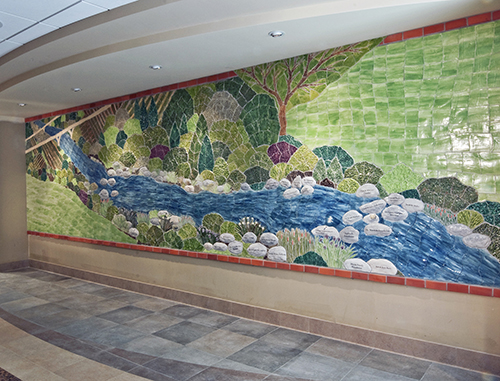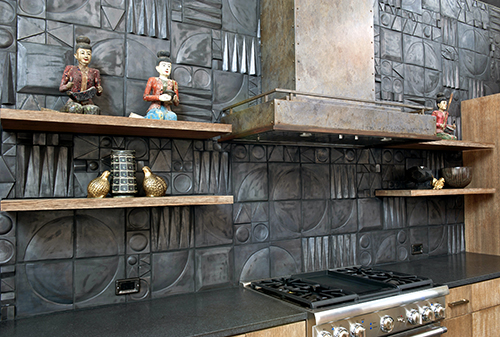Ceramic artist Karen Singer developed a business model serving a niche market and is expanding into new sectors. We spoke about her strategy and insights for other artists.

AS: You built a business serving a specific niche market, to recognize donor contributions. How did you do that?
KS: Early on, I had a couple friends who worked in fundraising. I had made tiles that depicted building facades and these friends told me that fundraising professionals were always looking for gifts for donors that had a personal connection. Thus, the idea of doing a tile of a specific building on a campus came into being. We then explored conferences for fundraisers and started calling fundraising professionals.
This expanded into creating gigantic ceramic tile murals that create a portrait of each client’s (frequently a hospital, university, private school, or retirement community) core mission and identity. We have made murals as large as 60 feet wide x 10 feet tall. We have also developed donor recognition systems that include naming plaques, signage, gifts to donors and other related work, all keyed together visually.
A major breakthrough came when we started looking at the amounts our clients had raised in relation to their planned goals. Those who brought us in early in the process to develop the design were having incredible success. These clients all met their fundraising goals (not something that always occurs), and several exceeded the goal by millions! According to these clients, using the design materials as a part of the strategic plan, case statement and visits to early donor prospects was making a big difference for them.
Over time, I have learned a lot about fundraising from my extraordinary clients, from trial and error, and from researching the field. I have also learned a lot about the process of making a commissioned work of art, something that is not talked about in most college art programs.

AS: How have you expanded your business to other market sectors?
KS: This is ongoing. The challenge with donor recognition is that there is a very long sales cycle, dependent on a lot of factors outside my control, such as committees, long term schedules, and construction planning. These are very visible projects with many stakeholders who care deeply about the final product.
Beyond the world of donor recognition, I have learned that my work is attractive to people looking for art that they cannot find commercially; work that expresses an idea of mission, work that creates a portrait of a place or an organization, work that creates a bridge between cultures.
Specifically, we are exploring market sectors such as:
- residential (architects, designers and homeowners who want something highly custom)
- ceramics for building exteriors – this can be retail signage, architectural ornamentation, commercial branding or historic markers
- community development corporations – doing tiles as donor gifts, historic markers, tile workshops for community members, etc.

AS: How are you involved in collaborating with others to create a new revenue stream?
We are collaborating with community development corporations. We have contracted with a historic garden for a series of educational marker tiles that illustrate pollination. I’m also working with a mosaic artist who is collaborating on a series of special workshops. There are many organizations for whom we do workshops, including team building for corporations, retirement communities, schools, parties, and class projects.
AS: Looking back at your career, what insights do you have to share with other artists who are looking to structure their own businesses?
KS: Learn as much as you can about how to successfully navigate a commissioned art project. This involves really good communication skills, especially good listening and mirroring what you hear. Price to include a profit factor, and stick to what you promised the client, unless they change the parameters.
Learn how to talk about your work to people who may not be familiar with “art talk”. Find the people who naturally gravitate to what you do and listen to what they say about it. This language will help you talk to other people who may be good clients.
Great art changes perception. This can be a powerful force for good. Artists have an amazing ability to help people feel better, by expanding their sense of what is possible, by expressing emotion, by gaining a sense of empowerment, or simply by beautifying a space. The world is very visual, and artists are trained to help people see things in new ways.


Very cool. I hope an event starting on Sept. 19th for me to support the local Chula Vista Animal Shelter will give me opportunity to give something special for donors. The event is Art for Animals and people bring gifts for animals in the shelter. My art will be for sale with a 20% of my sale to go to the shelter.. I think there are many eager donors in the community. I like how the ceramic artist chose her niche.
Good luck, and let me know how it goes!
Art is everywhere and investing in an art business is a great idea! Thank you for sharing these wonderful tips.
Love this post thanks for sharing.